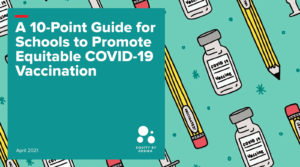Uneven Vaccination Rates Are Creating Two Americas: Schools Can Help Advance Vaccine Equity.

As the struggle with COVID-19 wanes for some and grows for others, we are seeing the accelerated bifurcation of two Americas.
In one America, vaccinated people are traveling, eating out, and hugging loved ones with much less risk of transmission and serious illness. With mask requirements lifted in many public places, life is beginning to feel almost normal.
But in the other America—the one with low vaccination rates—the COVID-19 virus, including the more transmissible Delta variant, is raging on. A closer look reveals the disparities between these two Americas: According to research by the Kaiser Family Foundation, vaccination rates vary significantly across racial and ethnic groups and by state. The report’s authors concluded that if vaccination continues at the same pace, substantial disparities will remain, especially in Hispanic, Black, and some rural communities.
While America missed our national goal of 70% of adults vaccinated by July 4, we still have the opportunity to help communities overcome vaccine hesitancy and get their COVID-19 shots—if we get schools involved and fully mobilized. Schools have the depth and reach into communities that have been missing from our national vaccination effort. Moreover, schools have a vested interest in combating vaccine inequality, which is exacerbating education inequality.
Since March 2020, America has taken a patchwork approach to fight this virus. Vaccine rollout has also been uneven: Today, 55% of all people in the US have received at least one shot, with full vaccination rates ranging from more than 65% in Vermont to less than 30% in Mississippi. Meanwhile, rates of new vaccination are dropping.
These data point to a related risk: that vaccine unevenness will exacerbate education inequality, which exists in some of the same areas where vaccine rates are low, including parts of the South; rural regions across the Southwest and Midwest; and among some Black, Indigenous, and people of color (BIPOC) communities.
According to analysis of CDC data, while vaccination rates have increased recently among Black and Brown communities, an overwhelming number of people in these demographics are still grappling with the decision to vaccinate. These same communities have experienced greater hardship during the pandemic, including higher rates of COVID-19 sickness and death and loss of income and employment.
Education outcomes among these groups have also declined: A McKinsey study found that the shift to remote schooling in the spring of 2020 set white students back by one to three months in math, while students of color lost three to five months. Research has shown that during the pandemic, people of color were 15% more likely to enroll in remote schools, while white people were more likely to have access to at least some schooling in person.
If vaccine inequality is not addressed, we’re on the path for deeper inequalities: In communities where most people are vaccinated, schools will reopen in the fall for in-person learning, and parents will no longer have to juggle work and homeschool. In communities where most people are not yet getting vaccinated, classroom closures and inconsistent attendance may prevent families from returning to employment, while students experience greater learning loss, social isolation, and mental distress due to localized COVID-19 resurgence. To protect whole communities—and ensure equal access to post-pandemic life—we need to achieve herd immunity, which we’ll reach if roughly 75% to 85% of the general public gets vaccinated. While most people have access to the COVID-19 vaccine, significant “vaccine deserts” remain where residents do not have convenient, practical access, often in communities that need vaccines most. Schools can help: Across the nation, there are roughly two public schools for every ZIP code. Schools are often some of the most trusted institutions in their communities, and they have the broadest and deepest reach into the everyday lives of Americans.
Principals, teachers, and school social workers can talk to students and families in ways that government leaders cannot, which allows them to address nuanced matters like misinformation, complacency, fear, and distrust of science that feed vaccine hesitancy. The reach of schools is also diverse and multigenerational, as students leave school buildings to return to communities of every background, race, faith, and political persuasion.
Schools can increase access to vaccination through onsite clinics for students, families, and staff; case management to complete appointments; and partnerships that lower costs of getting the jab. Teachers and school leaders can combat vaccine hesitancy by teaching the science, providing families with curated resources, and taking the time to ensure all school community members have their concerns addressed.
Together, we can help the country overcome this virus so that our school communities can get back to the important work of educating young people for the future.
For more, see:
- How Schools Can Promote Vaccination and Address Hesitancy: A 10-Point Plan that Puts Equity First
- Why We Built a Hub for Vetted Vaccination Resources for Public Schools
Stay in-the-know with innovations in learning by signing up for the weekly Smart Update.







0 Comments
Leave a Comment
Your email address will not be published. All fields are required.